Polenta bread – molto delicious

Words in Italian seem to add a layer of glamour, mystery or just plain cuteness to anything they name (except when multi-nationals try to brand inferior products in that way). Take putti for instance the Italian for the rosy-cheeked cherubs that grace so many of the Renaissance paintings and Sistine chapel. You have to purse your mouth into a kiss just to say the word (pooti). The humble pine kernel – it’s a plain-souding thing until you use La Bella Lingua. Pignoli rolls around the mouth and ends in a smile. Cornmeal is so drab compared with polenta (big stress on the second syllable) which was a key ingredient in this month’s Fresh From the Oven challenge set by Becky from Fraxnits.
I’ve had a few problems with the last two challenges (my walnut bread stuck and my brioche …well, watch this space) so I was rather keen that this loaf would turn out alright (a baking blogger who can’t bake…?). It was easy to cook the polenta but when combined with the flour it looked a bit unmanageable to mix by hand so I used the paddle on my Kitchenaid to combine then changed to the dough hook to knead the very sticky dough. I turned the dough out onto a floured surface and then returned it to the cleaned bowl to let it rise. The weather has started to cool down here in Dubai, so I braved leaving it on my patio (on a jar so ants couldn’t crawl in). I used the same mixing method for the next stage and after the second rise, set about knocking back and plaiting. I was very satisfied as I popped it into the hot oven and the loaf turned out really well – a sweet, slightly chewy but light texture. It was delicious with a soft, herby goats cheese. But look what I found left on the kitchen counter.
The pignoli for the top. I did consider toasting them and sticking them on by hand for the picture – but life’s too short isn’t it? Nessuno è perfetto!
Take a moment to pop over to the Fresh From the Oven site to see how everyone else’s polenta bread turned out. Recipe below – love to hear from you in the comments.
- Combining the cooked polenta with the flour
- My method for keeping ants off the proving dough
- Some of the ingredients including jolly Aunt Jemima
- Dough – smooth and elastic
- Starting to rise
- A simple plait or twist
- A nice golden colour
- Polenta bread
- Ready for slicing
- Sweet pine nuts embedded in the soft bread
- Poor forgotten pignoli
- With soft goats cheese
Polenta Bread Recipe
50g polenta
300ml lukewarm water
15g fresh yeast or 5g active dried yeast
1/2 tsp clear honey
225g white bread flour
25g butter
3 tbsp pine nuts
1 and 1/2 tsp salt
For the topping
1 egg yolk
1 tbsp water
pine nuts for sprinkling
Makes 1 loaf
1. Lightly grease a baking sheet. Mix the polenta and 250ml of the water together in a pan and slowly bring to the boil, stirring continuously with a large wooden spoon. Reduce the heat and simmer for 2-3 minutes, stirring occasionally. Set aside to cool for 10 minutes, or until just warm.
2. In a small bowl, mix the yeast with the remaining water and honey until creamy/frothy (depending on the yeast being fresh/dry). Sift 115g of the flour into a larger bowl. Gradually beat in the yeast mixture, then gradually stir in the polenta mixture to combine. Turn out on to a lightly floured surface and knead for 5 minutes until smooth and elastic.
3. Cover the bowl with lightly oiled cling film and leave the dough to rise in a warm place for 2 hours or until it has doubled in bulk.
4. Melt the butter in a small pan add the pine nuts and cook over a medium heat, stirring, until the pale and golden. Set aside to cool.
5. Add the remaining flour and salt to the polenta dough and mix to a soft dough. Knead in the pine nuts cooked in butter (and the butter). Turn out on to a lightly floured surface and knead for 5 minutes until smooth and elastic.
6. Place in a lightly oiled bowl, cover with lightly oiled cling film and leave to rise in a warm place for about 1 hour or until doubled in bulk.
7. Knock back (punch down) and turn the dough out on to a lightly floured surface. Cut the dough into two equal pieces and roll each piece into a fat sausage about 38 cm/15 inches long. Plait (braid) together the two pieces and place on the baking sheet. Cover with lightly oiled cling film and leave in a warm place for 45 minutes. Pre-heat the oven to 200 C/ 400 F/ Gas Mark 6.
8. Mix the egg yolk and water and brush over the loaf. Sprinkle with the pine nuts and bake for 30 minutes or until golden and sounding hollow when tapped on the base. Cool on a wire rack.
Comments are closed.

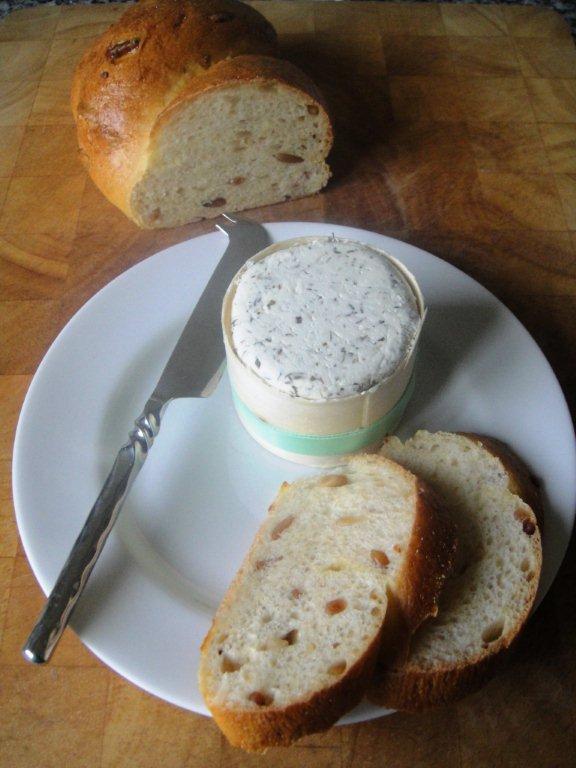
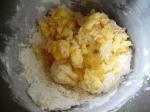
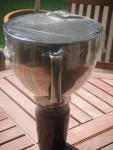
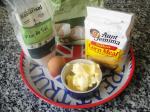

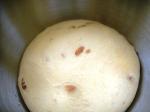
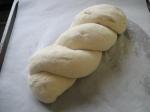
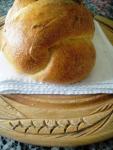

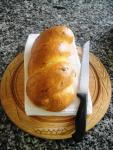
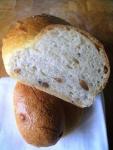
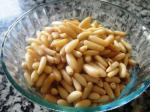
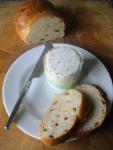











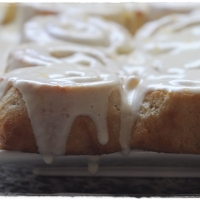











Looks delish! I have a stock pile of polenta, since I cant seem to cook the stuff into anything I actually want to eat (wallpaper paste anyone?) so this is great, thanks!
I know what you mean about the wallpaper paste! The polenta adds a firm texture to this bread – try and see what you think (and don’t forget the topping!)
Ha ha! I feel the same about polenta. Hence the pack I used was out of date as it sits there forever. I just can’t get to grips with it, and that’s coming from someone who loves stodge!
It does add a great depth to this bread though, and I sometimes sprinkle it on the base of other breads and pizza bases too.
Glad to see I am not the only ‘nut forgetter’ Sally. I wish it was still warm enough to prove dough outside here. It’s really dropped cold this week.
Yes Claire, polenta is one of those things I think I ought to like more – husband and teens reaction stop me from persevering! Silvia and Claire loved seeing how your loaves turned out too.
I really enjoyed this challenge too and I don’t like polenta! Great looking bread. Thanks for taking part.
Nice one Sally, and with the goat cheese, nom nom!
It was certainly yum!
I have just had the remains toasted for lunch. Delicious.
I left off the pine nuts on top as well–and I see from others’ creations that they often burned, so that was fortunate. 🙂 I loved the pine nuts inside, though, and found the bread very tasty.
I am so pleased you enjoyed it – I was a bit worried after I posted about the triple rise and worried people might find it too much but everyone seems to have found it very tasty in the end.
I think that leaving the pine nuts off the top is a good idea as I can’t see how they just wouldn’t end up burning (as mine did) so you are better off without in my opinion!
I was just going thru ur posts. Ur bread really looks yummy however I wud like to ask a question what kind of oven r u using bec my bread comes out very hard
Thanks nuwera
I use an electric oven Nuwera. Try the following for a softer crust:
Make sure the oven is hot enough (I use an oven thermometer to make sure) otherwise you will have to leave the bread in for a long time to cook so it dries out,
Put a roasting tray of boiling water on the bottom shelf or use a water spray and give a few squirts into the oven to make some steam,
You can brush the top of your loaf with milk to make a softer crust,
Some people brush some butter or oil onto the top of the crust and wrap in a towel. Once cooled, they put into plastic. Personally I like a crusty top.
Use a recipe that contains some fat – some loaves are meant to be hard.
Hope this helps – let me know how you get on.
P.S. The polenta bread is quite soft – try it.